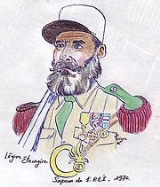
Sapper
Encyclopedia
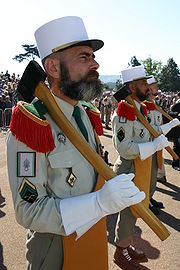
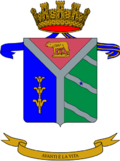
Combatant
A combatant is someone who takes a direct part in the hostilities of an armed conflict. If a combatant follows the law of war, then they are considered a privileged combatant, and upon capture they qualify as a prisoner of war under the Third Geneva Convention...
soldier
Soldier
A soldier is a member of the land component of national armed forces; whereas a soldier hired for service in a foreign army would be termed a mercenary...
who performs a wide variety of combat engineering
Combat engineering
A combat engineer, also called pioneer or sapper in many armies, is a soldier who performs a variety of construction and demolition tasks under combat conditions...
duties, typically including, but not limited to, bridge
Bridge
A bridge is a structure built to span physical obstacles such as a body of water, valley, or road, for the purpose of providing passage over the obstacle...
-building, laying or clearing minefields, demolitions, field defences, general construction and building, as well as road and airfield construction and repair. They are also trained to serve as infantry personnel when needed in both defensive and offensive operations and are fully involved in modern counter-insurgency operations. A sapper's tasks have, throughout history, including modern day counter-insurgency operations, been devoted to the mission-critical tasks involving facilitating movement and logistics of allied forces and impeding those of enemies.
The term "sapper" is used in the British Army
British Army
The British Army is the land warfare branch of Her Majesty's Armed Forces in the United Kingdom. It came into being with the unification of the Kingdom of England and Scotland into the Kingdom of Great Britain in 1707. The new British Army incorporated Regiments that had already existed in England...
, Polish Army and Commonwealth
Commonwealth
Commonwealth is a traditional English term for a political community founded for the common good. Historically, it has sometimes been synonymous with "republic."More recently it has been used for fraternal associations of some sovereign nations...
nations' military services. In the United States Army
United States Army
The United States Army is the main branch of the United States Armed Forces responsible for land-based military operations. It is the largest and oldest established branch of the U.S. military, and is one of seven U.S. uniformed services...
and United States Air Force
United States Air Force
The United States Air Force is the aerial warfare service branch of the United States Armed Forces and one of the American uniformed services. Initially part of the United States Army, the USAF was formed as a separate branch of the military on September 18, 1947 under the National Security Act of...
, the term sapper leader has been instituted to indicate combat engineers who have met additional professional qualifications that demonstrate a certain level of proficiency and accomplishment as a small unit leader of combat engineers. An ordinary engineer who has completed his training is called a pioneer. The German Army
German Army
The German Army is the land component of the armed forces of the Federal Republic of Germany. Following the disbanding of the Wehrmacht after World War II, it was re-established in 1955 as the Bundesheer, part of the newly formed West German Bundeswehr along with the Navy and the Air Force...
uses the term Pionier, while sapeur is used in the French Army
French Army
The French Army, officially the Armée de Terre , is the land-based and largest component of the French Armed Forces.As of 2010, the army employs 123,100 regulars, 18,350 part-time reservists and 7,700 Legionnaires. All soldiers are professionals, following the suspension of conscription, voted in...
, and guastatore (more precisely defined as an assault engineer) in the Italian Army
Italian Army
The Italian Army is the ground defence force of the Italian Armed Forces. It is all-volunteer force of active-duty personnel, numbering 108,355 in 2010. Its best-known combat vehicles are the Dardo infantry fighting vehicle, the Centauro tank destroyer and the Ariete tank, and among its aircraft...
.
Sapper
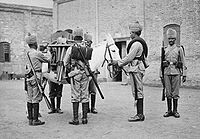
Sapping
Mining, landmining or undermining is a siege method which has been used since antiquity against a walled city, fortress, castle or other strongly held and fortified military position.-Antiquity:...
the enemy fortifications.
Saps were excavated by brigades of trained sappers or instructed troops. When an army was defending a fortress with cannon, they had an obvious height and therefore range advantage over the attacker's own guns. The attacking army's artillery had to be brought forward, under fire, so as to facilitate effective counter-battery fire
Counter-battery fire
Counter-battery fire is a type of mission assigned to military artillery forces, which are given the task of locating and firing upon enemy artillery.-Background:...
.
This was achieved by digging what the French termed a 'Sappe'. Using techniques developed and perfected by Vauban
Vauban
Sébastien Le Prestre, Seigneur de Vauban and later Marquis de Vauban , commonly referred to as Vauban, was a Marshal of France and the foremost military engineer of his age, famed for his skill in both designing fortifications and breaking through them...
, the sapeurs (sappers) began the trench at such an angle so as to avoid enemy fire 'enfilading' (passing directly along) the sappe. As they pressed forward, a position was prepared from which cannon could suppress the defenders on the bastions. The sappers would then change the course of their trench, zig-zag
Zigzag
A zigzag is a pattern made up of small corners at variable angles, though constant within the zigzag, tracing a path between two parallel lines; it can be described as both jagged and fairly regular....
ging their way toward the fortress wall.
Each leg brought the attacker's artillery closer and closer until (hopefully) the besieged cannon would be sufficiently suppressed for the attackers to breach the walls with their artillery. Broadly speaking, sappers were originally experts at demolishing or otherwise overcoming or bypassing fortification systems.
Miner

Commonwealth of Nations
Sapper (abbreviated Spr) is the Royal EngineersRoyal Engineers
The Corps of Royal Engineers, usually just called the Royal Engineers , and commonly known as the Sappers, is one of the corps of the British Army....
' equivalent of Private
Private (rank)
A Private is a soldier of the lowest military rank .In modern military parlance, 'Private' is shortened to 'Pte' in the United Kingdom and other Commonwealth countries and to 'Pvt.' in the United States.Notably both Sir Fitzroy MacLean and Enoch Powell are examples of, rare, rapid career...
. This is also the case within the Indian Army Corps of Engineers
Indian Army Corps of Engineers
The Indian Army Corps of Engineers has a long and illustrious history dating back to the mid-18th century. The earliest existing subunit of the Corps dates back to 1777 while the Corps officially recognises its birth as 1780 when the senior most group of the Corps, the Madras Sappers were...
, Canadian Military Engineers
Canadian Military Engineers
The Canadian Military Engineers is the military engineer branch of the Canadian Forces.-Mission:The mission of the Canadian Military Engineers is to contribute to the survival, mobility, and combat effectiveness of the Canadian Forces...
, Royal Australian Engineers
Royal Australian Engineers
The Royal Australian Engineers is a corps of the Australian Army . The RAE is ranked fourth in seniority of the corps of the Australian Army, behind the Staff Cadets, Armoured and Artillery Corps...
, South African Army Engineer Formation
South African Army Engineer Formation
The South African Army Engineer Formation is the controlling entity of all South African Army military engineering units.-Regular Units:* Engineer Formation HQ* School of Engineers...
and Royal New Zealand Engineers
Corps of Royal New Zealand Engineers
The 2nd Engineer Regiment is housed in Linton Military Camp that is situated approximately 10 km South of the City of Palmerston North. Raised on the 1st of July 1993 the Regiment is the only major military engineer Unit in the New Zealand Army. Linton Camp has been known throughout the Army...
. The term Sapper was introduced in 1856 when the Corps of Royal Sappers and Miners was amalgamated with the officer Corps of Royal Engineers
Royal Engineers
The Corps of Royal Engineers, usually just called the Royal Engineers , and commonly known as the Sappers, is one of the corps of the British Army....
to form the Corps of Royal Engineers
Royal Engineers
The Corps of Royal Engineers, usually just called the Royal Engineers , and commonly known as the Sappers, is one of the corps of the British Army....
.
Indian Army
The term 'Sappers', in addition to the connotation of rank of engineer private, is used collectively to informally refer to the Engineer CorpsIndian Army Corps of Engineers
The Indian Army Corps of Engineers has a long and illustrious history dating back to the mid-18th century. The earliest existing subunit of the Corps dates back to 1777 while the Corps officially recognises its birth as 1780 when the senior most group of the Corps, the Madras Sappers were...
as a whole and also forms part of the informal names of the three combat engineer groups, viz. Madras Sappers, Bengal Sappers and the Bombay Sappers. Each of these groups consist of about twenty battalion-sized engineer regiments and additional company-sized minor engineer units. The three Sapper groups are descended from the Sapper and Miner groups of the East India Company
East India Company
The East India Company was an early English joint-stock company that was formed initially for pursuing trade with the East Indies, but that ended up trading mainly with the Indian subcontinent and China...
and later the British Indian Army
British Indian Army
The British Indian Army, officially simply the Indian Army, was the principal army of the British Raj in India before the partition of India in 1947...
of the British Raj
British Raj
British Raj was the British rule in the Indian subcontinent between 1858 and 1947; The term can also refer to the period of dominion...
.
Israel Defence Forces
In the Israel Defence Forces a sapper (in Hebrew: פלס, palas) is the military profession of a combat soldier who went through basic combat engineeringCombat engineering
A combat engineer, also called pioneer or sapper in many armies, is a soldier who performs a variety of construction and demolition tasks under combat conditions...
training. Most of the sappers are soldiers of the Combat Engineering Corps, but there are also infantry sappers, who are part of the infantry
Infantry
Infantrymen are soldiers who are specifically trained for the role of fighting on foot to engage the enemy face to face and have historically borne the brunt of the casualties of combat in wars. As the oldest branch of combat arms, they are the backbone of armies...
brigade
Brigade
A brigade is a major tactical military formation that is typically composed of two to five battalions, plus supporting elements depending on the era and nationality of a given army and could be perceived as an enlarged/reinforced regiment...
s and are organized in Engineering companies
Company (military unit)
A company is a military unit, typically consisting of 80–225 soldiers and usually commanded by a Captain, Major or Commandant. Most companies are formed of three to five platoons although the exact number may vary by country, unit type, and structure...
called פלחה"ן (Palchahan). These companies are integral part of the infantry brigades. Combat engineering corps sappers are arranged in battalions.
Each sapper goes through high level infantry training, which qualifies him as Rifleman
Rifleman
Although ultimately originating with the 16th century handgunners and the 17th century musketeers and streltsy, the term rifleman originated from the 18th century. It would later become the term for the archetypal common soldier.-History:...
07 (רובאי 07). Combat engineering sappers are qualified as Sapper 06 (פלס 06). They are skilled in infantry
Infantry
Infantrymen are soldiers who are specifically trained for the role of fighting on foot to engage the enemy face to face and have historically borne the brunt of the casualties of combat in wars. As the oldest branch of combat arms, they are the backbone of armies...
combat, basic sabotage
Sabotage
Sabotage is a deliberate action aimed at weakening another entity through subversion, obstruction, disruption, or destruction. In a workplace setting, sabotage is the conscious withdrawal of efficiency generally directed at causing some change in workplace conditions. One who engages in sabotage is...
, landmine planting and demining
Demining
Demining or mine clearance is the process of removing either land mines, or naval mines, from an area, while minesweeping describes the act of detecting of mines. There are two distinct types of mine detection and removal: military and humanitarian.Minesweepers use many tools in order to accomplish...
, use of explosives, breaching and opening routes, trench warfare
Trench warfare
Trench warfare is a form of occupied fighting lines, consisting largely of trenches, in which troops are largely immune to the enemy's small arms fire and are substantially sheltered from artillery...
, and operating the IDF Puma
IDF Puma
The Puma is a heavily armored Combat engineering vehicle and armored personnel carrier that the Engineering Corps of the Israeli Defence Forces has used since the early 1990s. The vehicle can carry a crew of to eight...
combat engineering vehicle
Combat engineering vehicle
Military engineering vehicles are vehicles built for the construction work or for the transportation of combat engineers on the battlefield. These vehicles can range from civilian equipment to purpose built military vehicles....
(CEV). Combat engineering commanders are qualified as Sapper 08 while combat engineering officer
Officer (armed forces)
An officer is a member of an armed force or uniformed service who holds a position of authority. Commissioned officers derive authority directly from a sovereign power and, as such, hold a commission charging them with the duties and responsibilities of a specific office or position...
s are qualified as Sapper 11. Both go through additional advance training to gain the skills needed for high level sapper profession.
France
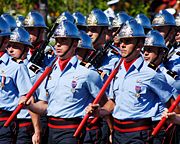
Paris Fire Brigade
The Paris Fire Brigade , is a French Army unit which serves as the fire service for Paris and certain sites of national strategic importance....
and other town or country brigades are called "sappers-firemen" (sapeurs-pompiers
Sapeur-pompier
The fire service in France is known as Sapeurs-pompiers, except in Marseille, where naval "sailor-firefighters", marins-pompiers, provide fire and rescue services.There are two categories:...
, SP): the first fire company created by Napoléon I
Napoleon I
Napoleon Bonaparte was a French military and political leader during the latter stages of the French Revolution.As Napoleon I, he was Emperor of the French from 1804 to 1815...
was a military sappers company. Apart from this, the sappers are the combat engineers.
The sappers were very common in the French army and in other European armies during the Napoleonic era but progressively disappeared in the 19th century, except in the French Foreign Legion
French Foreign Legion
The French Foreign Legion is a unique military service wing of the French Army established in 1831. The foreign legion was exclusively created for foreign nationals willing to serve in the French Armed Forces...
, which retains a sapper unit.
In the French Army
French Army
The French Army, officially the Armée de Terre , is the land-based and largest component of the French Armed Forces.As of 2010, the army employs 123,100 regulars, 18,350 part-time reservists and 7,700 Legionnaires. All soldiers are professionals, following the suspension of conscription, voted in...
, since the 18th century, every grenadier battalion had a small unit of sappers. They had the mission to advance, under the enemy's fire, in order to destroy with their axes the obstacles drawn by the enemy and to clear the way for the rest of the infantry
Infantry
Infantrymen are soldiers who are specifically trained for the role of fighting on foot to engage the enemy face to face and have historically borne the brunt of the casualties of combat in wars. As the oldest branch of combat arms, they are the backbone of armies...
. The danger of such missions and their short life expectancies, allowed them certain privileges, such as the authorization to wear beards. In addition to their beards and axes, they traditionally wear leather aprons and gloves.
The current pioneer unit of the Legion reintroduced the symbols of the Napoleonic
Napoleonic Era
The Napoleonic Era is a period in the history of France and Europe. It is generally classified as including the fourth and final stage of the French Revolution, the first being the National Assembly, the second being the Legislative Assembly, and the third being the Directory...
sappers: the beard, the axe, the leather apron, the crossed-axes insignia
Insignia
Insignia or insigne pl -nia or -nias : a symbol or token of personal power, status or office, or of an official body of government or jurisdiction...
and the leather gloves. If the parades of the Legion are opened by this unit, it is to commemorate the traditional role of the sappers "opening the way" for the troops.
United States Army
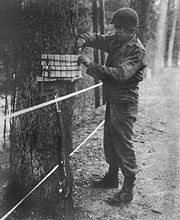
Infantry
Infantrymen are soldiers who are specifically trained for the role of fighting on foot to engage the enemy face to face and have historically borne the brunt of the casualties of combat in wars. As the oldest branch of combat arms, they are the backbone of armies...
, and they have fought in every war in American history. For example, after the Battle of Yorktown
Siege of Yorktown
The Siege of Yorktown, Battle of Yorktown, or Surrender of Yorktown in 1781 was a decisive victory by a combined assault of American forces led by General George Washington and French forces led by the Comte de Rochambeau over a British Army commanded by Lieutenant General Lord Cornwallis...
, General Washington cited Louis Lebègue Duportail, the U.S. Army's first Chief of Engineers, for conduct which afforded "brilliant proofs of his military genius."
Designation as a sapper nowadays is earned as an additional proficiency. The U.S. Army authorizes three skill tabs for permanent wear above the unit patch on the left shoulder (Army Regulation 670-1 Chapter 29-13, Sub-Paragraph f). Along with the Sapper Tab
Sapper Tab
The Sapper Tab is a military badge of the United States Army which was authorized on June 28, 2004 by the Army Chief of Staff, General Peter Schoomaker....
, the Special Forces Tab
Special Forces Tab
The Special Forces Tab is a service school qualification tab of the United States Army, awarded to any soldier completing either the Special Forces Qualification Course, or the Special Forces Detachment Officer Qualification Course , at the U.S. Army John F...
and the Ranger Tab
Ranger Tab
The Ranger Tab is a service school military decoration of the United States Army signifying completion of the 61-day long Ranger School course in small-unit infantry combat tactics in woodland, mountain, and swamp operations. In December 2009 a British NCO earned the Ranger tab...
identify soldiers who have passed a demanding course of military instruction and demonstrated their competence in particular specialities and skills.
To wear the Sapper Tab, a soldier must complete the Sapper Leader Course (SLC) which is operated by the U.S. Army Engineer School at Fort Leonard Wood
Fort Leonard Wood (military base)
Fort Leonard Wood is a United States Army installation located in the Missouri Ozarks. The main gate is located on the southern boundary of St. Robert. The post was created in December 1940 and named in honor of General Leonard Wood, former Chief of Staff, in January 1941...
, Missouri
Missouri
Missouri is a US state located in the Midwestern United States, bordered by Iowa, Illinois, Kentucky, Tennessee, Arkansas, Oklahoma, Kansas and Nebraska. With a 2010 population of 5,988,927, Missouri is the 18th most populous state in the nation and the fifth most populous in the Midwest. It...
. The Sapper Leader Course is a 28-day course designed to train joint-service leaders in small unit tactics, leadership skills, and tactics required to perform as part of a combined arms team. The course is open to enlisted soldiers in the grades of E-4 (P) (in the Army, specialist on the list for promotion to sergeant) E-5, and above, cadets, and officers O-3 (Army, captain) and below. Students can come from any combat or combat support branch of the service, but priority is given to engineering, cavalry, and infantry soldiers.
PAVN and Viet Cong
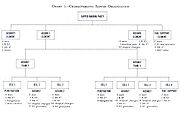
Vietnam People's Army
The Vietnam People's Army is the armed forces of Vietnam. The VPA includes: the Vietnamese People's Ground Forces , the Vietnam People's Navy , the Vietnam People's Air Force, and the Vietnam Marine Police.During the French Indochina War , the VPA was often referred to as the Việt...
and Viet Cong sappers, as they were called by US forces, are better described as commando
Commando
In English, the term commando means a specific kind of individual soldier or military unit. In contemporary usage, commando usually means elite light infantry and/or special operations forces units, specializing in amphibious landings, parachuting, rappelling and similar techniques, to conduct and...
units. The Vietnamese term "đặc công" can be literally translated as "special task". Thousands of specially trained elite fighters served in the PAVN and Viet Cong commando/sapper units which were organized as independent formations. While not always successful due to lack of appropriate personal weapon types for combat and assault like other special forces
Special forces
Special forces, or special operations forces are terms used to describe elite military tactical teams trained to perform high-risk dangerous missions that conventional units cannot perform...
, at times they inflicted heavy damage against their enemies. They have been armed with various types of bombs, mines, explosive charges, grenades and even steel-pellet mines which were much more devastating than the U.S M18 Claymore and are still the main weapons of the Dac cong. These elite units served as raiders against American/ARVN
Army of the Republic of Vietnam
The Army of the Republic of Viet Nam , sometimes parsimoniously referred to as the South Vietnamese Army , was the land-based military forces of the Republic of Vietnam , which existed from October 26, 1955 until the fall of Saigon on April 30, 1975...
troops, and infiltrated spearheads during the final Ho Chi Minh Campaign
Ho Chi Minh Campaign
The Hồ Chí Minh Campaign was the final title applied to a series of increasingly large-scale and ambitious offensive operations by the Democratic Republic of Vietnam and the National Front for the Liberation of South Vietnam which began on 13 December 1974...
in 1975 – where they seized key road and bridge assets, destroyed installations, attacked command and control nodes located deep inside enemy territory, and otherwise helped the PAVN's rapid mobile forces advance. A typical PAVN/VC Dac cong organization is shown in the diagram. The raiding force was usually grouped into assault teams, each broken down into several 3–5 man assault cells. Overall, there were generally 4 operational echelons
Echelon formation
An echelon formation is a military formation in which members are arranged diagonally. Each member is stationed behind and to the right , or behind and to the left , of the member ahead...
.
Honours
Sapper Island, St. Joseph Channel, Algoma District, OntarioAlgoma District, Ontario
Algoma District is a district and census division in Northeastern Ontario in the Canadian province of Ontario. It was created in 1858 comprising territory as far west as Minnesota...
was named in honour of Sappers, especially those who graduated from the Royal Military College of Canada
Royal Military College of Canada
The Royal Military College of Canada, RMC, or RMCC , is the military academy of the Canadian Forces, and is a degree-granting university. RMC was established in 1876. RMC is the only federal institution in Canada with degree granting powers...
.
46°18′56"N 83°57′29"W
See also
- Assault pioneerAssault PioneerAn Assault Pioneer is an infantry soldier who is responsible for:* The construction of tools for infantry soldiers to cross natural and man-made obstacles as well as breaching of enemy fortifications;...
- List of military engineer nomenclatures
- Trooper (rank)Trooper (rank)Trooper from the French "troupier" is the equivalent rank to private in a regiment with a cavalry tradition in the British Army and many other Commonwealth armies, including those of Australia, Canada, South Africa and New Zealand. Today, most cavalry units operate in the armoured role, equipped...
- Viet Cong and PAVN Sapper attacks
External links
- Royal Engineers Museum – History of the Royal Engineers (The Sappers)
- Royal Engineers Museum – Origins of the term "Sapper"
- http://www.sappers.co.uk/- Site for tracking down former members of the Royal Engineers.
- Dec 1918 Popular Science World War 1 article about a French engineer using a ground stethoscope to listen for German sappers – Listening to Enemy Sappers, Popular SciencePopular SciencePopular Science is an American monthly magazine founded in 1872 carrying articles for the general reader on science and technology subjects. Popular Science has won over 58 awards, including the ASME awards for its journalistic excellence in both 2003 and 2004...
monthly, January 1919, page 27, Scanned by Google Books - Sapper-Museum, virtual museum of Russian engineering troops
- A.-M. Zielenski , Colonel (sapper), Military Engineer
- Comandosupremo.com, guastatore.

